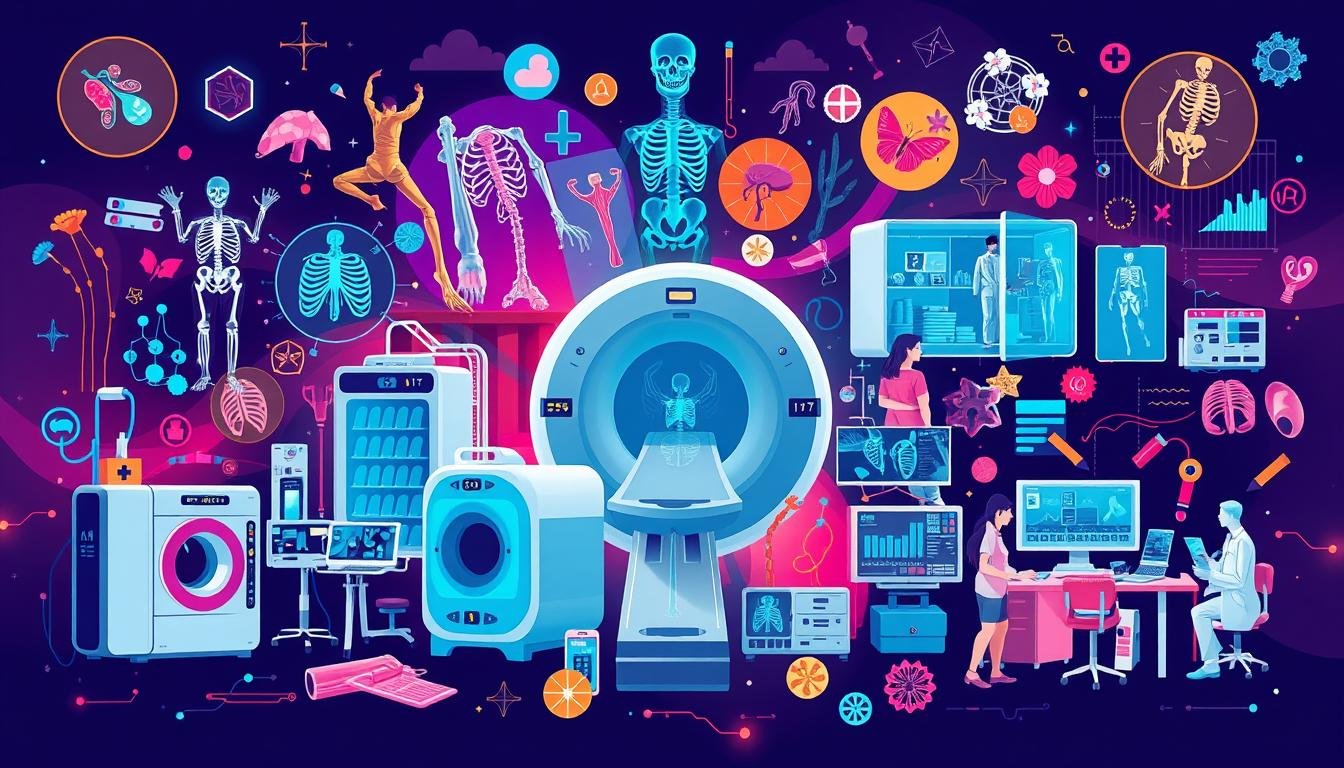Medical imaging careers are exciting and rewarding. X-ray tech school programs offer training in diagnostic imaging.
These programs equip students with knowledge and skills. Graduates can thrive as x-ray technicians in the healthcare field.
Finding top x-ray tech schools nearby is crucial. These programs provide hands-on experience and classroom instruction.
Students can earn certifications to start their careers. Radiologic technologists have many job opportunities after graduation.
A bright and modern X-ray tech classroom filled with advanced imaging equipment, students in lab coats working on X-ray machines, anatomical models displayed prominently, large windows allowing natural light to illuminate the space, a focused educational atmosphere, sleek desks and a technology-rich environment.
X-ray tech programs cover the core curriculum and accreditation. You’ll learn about program requirements and career prospects.
A strong educational foundation opens doors. Medical imaging is a dynamic field with many opportunities.
Understanding the Role of an X-Ray Technician
As an x-ray technician, you’ll play a key role in medical imaging. You’ll use advanced equipment to capture images that help diagnose medical conditions.
Radiologic technologist responsibilities include positioning patients and ensuring their comfort. You’ll work with other healthcare professionals to carry out imaging procedures.
The medical imaging career paths offer many options for X-ray technicians. You might work in hospitals, clinics, or specialized imaging centres.
Your role may involve general radiography or specialized procedures like mammography. You might also help with contrast media during imaging exams.
X-ray technicians need technical skills, patient care abilities, and attention to detail. These skills help you deliver top-notch medical care to patients.
Benefits of Attending an Accredited X-Ray Tech School
Accredited X-ray tech programs offer many perks. They meet high standards set by organizations like JRCERT.
These programs provide top-notch education and training. Students learn through hands-on experiences and important coursework.
They develop skills in patient care and image evaluation. This prepares them for the demands of the field.
Graduates from accredited schools have better job prospects. Many employers prefer hiring them over others.
This can lead to higher salaries and job security. Employers trust these graduates to provide excellent care.
Choosing an accredited program ensures a strong education. It sets up future X-ray techs for success.
Key Curriculum Components in X-Ray Tech Programs
X-ray tech programs offer a mix of theory and hands-on training. Students learn essential skills and knowledge for the field.
The curriculum starts with basic human anatomy and physiology. It also covers medical terms needed for the job.
Students study radiation physics and safety in their courses. They learn how X-rays work and how to protect patients.
Hands-on training is a key part of x-ray tech programs. Students practice in real medical settings under expert guidance.
This experience helps them master various imaging techniques. They learn proper positioning and image processing skills.
Financial Considerations for X-Ray Tech Programs
X-ray technician careers require careful financial planning. X-ray tech school costs can range from $10,000 to $30,000 or more.
Many financial aid options can make your education more affordable. Radiologic technology scholarships are a great option for x-ray tech students.
Organizations like the ASRT Foundation offer medical imaging scholarships. These can provide thousands of dollars for x-ray tech school tuition.
Grants, loans, and work-study programs are also available. These options can help reduce your out-of-pocket costs for X-ray tech school.
Research and planning can make X-ray tech programs more affordable. Understanding costs and aid options can help you achieve your career goals.
Finding X-Ray Tech Schools in Your Area
Searching for local X-ray tech schools is crucial for aspiring radiologic technologists. Resources are available to help you find the best medical imaging education nearby.
The radiologic technology program locator helps explore accredited programs in your area. It allows you to compare curricula, admission requirements, and other important factors.
When researching schools, consider program accreditation and clinical training opportunities. Many colleges offer radiologic technology programs.
Contact local schools to learn about their medical imaging education options. This will give you a better understanding of what’s available nearby.
Professional association websites offer comprehensive program locators. These tools help you find the best fit for your goals.
Take time to explore your options thoroughly. This ensures you select a high-quality program for success in healthcare.

Online vs. In-Person X-Ray Tech Programs
X-ray technician students can choose between online and in-person programs. Both options have their benefits and drawbacks.
Online x-ray tech programs offer flexibility for busy students. They combine digital lessons with hands-on training at local healthcare facilities.
In-person programs provide an immersive learning experience. Students learn from experienced instructors and use state-of-the-art medical imaging labs.
The choice depends on your learning style and lifestyle. Some students prefer a structured classroom environment.
Others thrive with the freedom of online learning. Hybrid medical imaging courses blend online and in-person training.
Consider your needs and goals when choosing a program. This will help you find the best fit for your future career.
Essential Skills for Success in X-Ray Technology
X-ray technicians need technical expertise and people skills. They must operate complex imaging equipment and analyze diagnostic images accurately.
Key skills include patient positioning and equipment adjustment. Producing high-quality X-rays is crucial for radiologic technology competencies.
Patient care skills are equally important. Good communication helps put patients at ease during procedures.
Patient care in medical imaging involves guiding patients through exams. Addressing concerns and ensuring comfort are vital parts of the job.
Critical thinking and problem-solving are essential for x-ray technicians. They must adapt to unique patient needs and troubleshoot equipment issues.
A well-rounded skill set is key to success. It helps technicians thrive in the ever-changing field of X-ray technology.
Licensing and Certification for X-Ray Technicians
X-ray technicians need to know their state’s licensing and certification rules. The ARRT certification is the top standard in radiologic technology.
To get ARRT certified, finish an accredited program and pass the exam. Most states also require a specific license or certification.
State rules can differ. Check the rules where you plan to work.
Some states may need extra education or training. This can include continuing education hours.
Ongoing learning is key for X-ray technicians. Many states and ARRT require yearly continuing education credits.
CE courses cover new imaging methods and safety rules. They help technicians give the best care.
Know the rules to be ready for your career. Get your ARRT certification and keep your state license current.
Stay informed about your field. This will help you succeed in radiologic technology.
Job Outlook and Salary Expectations for X-Ray Techs
X-ray technician jobs are growing fast. The Bureau of Labor Statistics predicts a 9% increase by 2030.
This growth is due to an ageing population. New medical imaging tech also plays a role.
X-ray techs earn good money. The median yearly salary is about $62,000.
Pay can vary based on location and experience. Urban areas often offer higher salaries.
X-ray techs have great career growth options. Keeping skills updated opens doors to leadership roles.
Some techs move into specialized fields. These include CT scanning or MRI.
Specializations Available in X-Ray Technology
X-ray technicians can explore various specialized fields within radiologic technology. Some choose to focus on advanced imaging like CT, MRI, or mammography.
CT specialists operate equipment that produces cross-sectional body images. These images help doctors detect and monitor many medical conditions.
MRI experts use magnetic fields and radio waves for detailed imaging. Mammography technicians perform breast cancer screenings using low-dose X-ray technology.
Pursuing specializations enhances your skills and opens new career opportunities. Employers often seek candidates with expertise in advanced imaging modalities.
Diversifying your skillset can boost your marketability in radiologic technology. It may also lead to higher salaries in this field.
A vibrant, dynamic illustration showcasing various specializations in X-ray technology, featuring a collage of high-tech X-ray machines like CT scanners, MRI machines, and portable X-ray units, surrounded by abstract representations of anatomy such as bones and organs, with an emphasis on diversity in medical settings—hospitals, clinics, and research labs—all in a harmonious blend of colours and futuristic elements.
How to Prepare for Your X-Ray Tech School Journey
Becoming an X-ray technician needs careful planning. Take classes in human anatomy, physics, and math to meet prerequisites.
Keep a strong academic record. Many programs require a minimum GPA for admission.
Create a standout application for your chosen programs. Show your passion for medical imaging in your statement.
Get healthcare experience through volunteer work or internships. This will make your application stronger.
Use online resources to learn about radiologic technology. The American Society of Radiologic Technologists (ASRT) offers great information.
Their website has career guides and skill-building tools. These resources will help you prepare for your future career.
FAQ
What is the role of an x-ray technician?
X-ray technicians operate imaging equipment to produce medical images. They help doctors diagnose and treat various medical conditions.
What are the benefits of attending an accredited X-ray tech school?
Accredited schools offer top-notch education in radiologic technology. Graduates are well-prepared for exams and have better job prospects.
What are the key components of an X-ray tech program’s curriculum?
X-ray tech programs blend classroom learning with hands-on training. Students study anatomy, radiation physics, imaging procedures, and patient care.
They also learn to operate various medical imaging equipment.
How can I find X-ray tech schools in my area?
Use online program locators to find accredited X-ray tech schools nearby. Check with local colleges and universities about their radiologic technology programs.
What are the licensing and certification requirements for x-ray technicians?
X-ray techs need ARRT certification and a state license to practice. The ARRT exam covers various aspects of radiologic technology.
State licensing rules may differ, so research your area’s regulations.
What are the job outlook and salary expectations for x-ray technicians?
The job outlook for x-ray techs is positive, and fast growth is expected. Salaries vary by location and experience, averaging around $60,000 annually.
How can I prepare for my x-ray tech school journey?
Complete prerequisite courses in biology, anatomy, and physics. Research application processes and deadlines for x-ray tech programs.
Explore professional associations and online forums to learn more about radiologic technology.
You may also read:Is Data Annotation Tech Legit: A Trusted Guide
